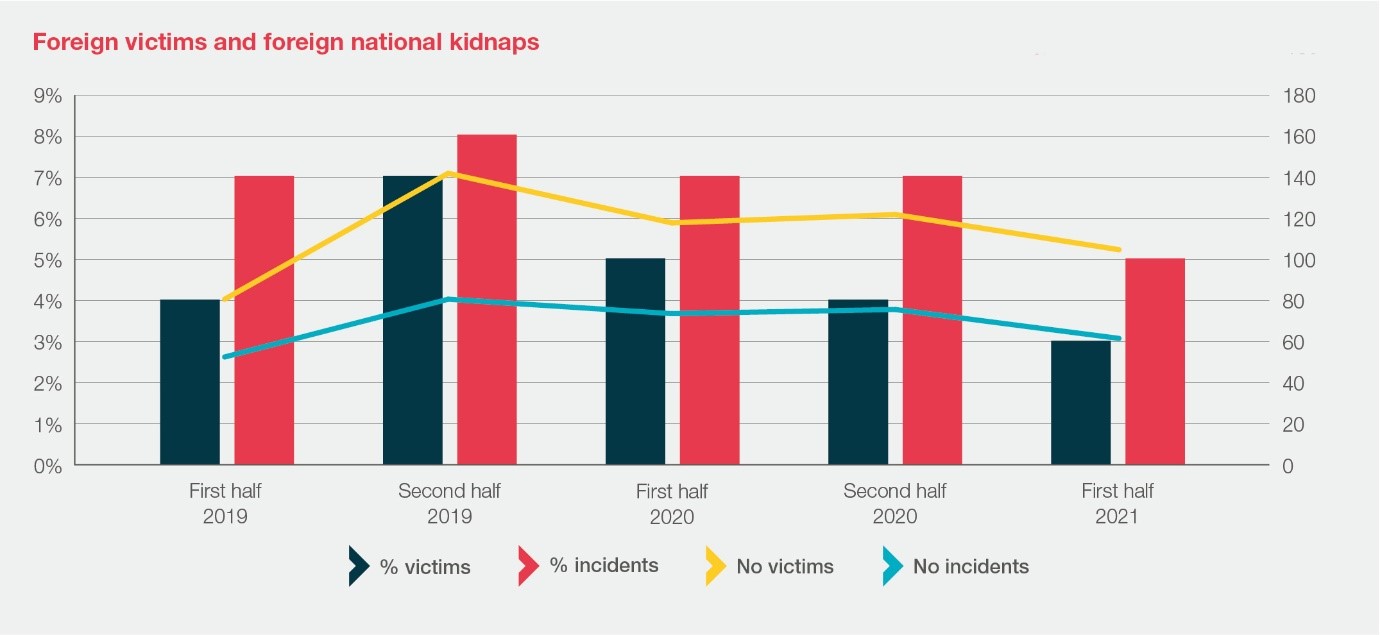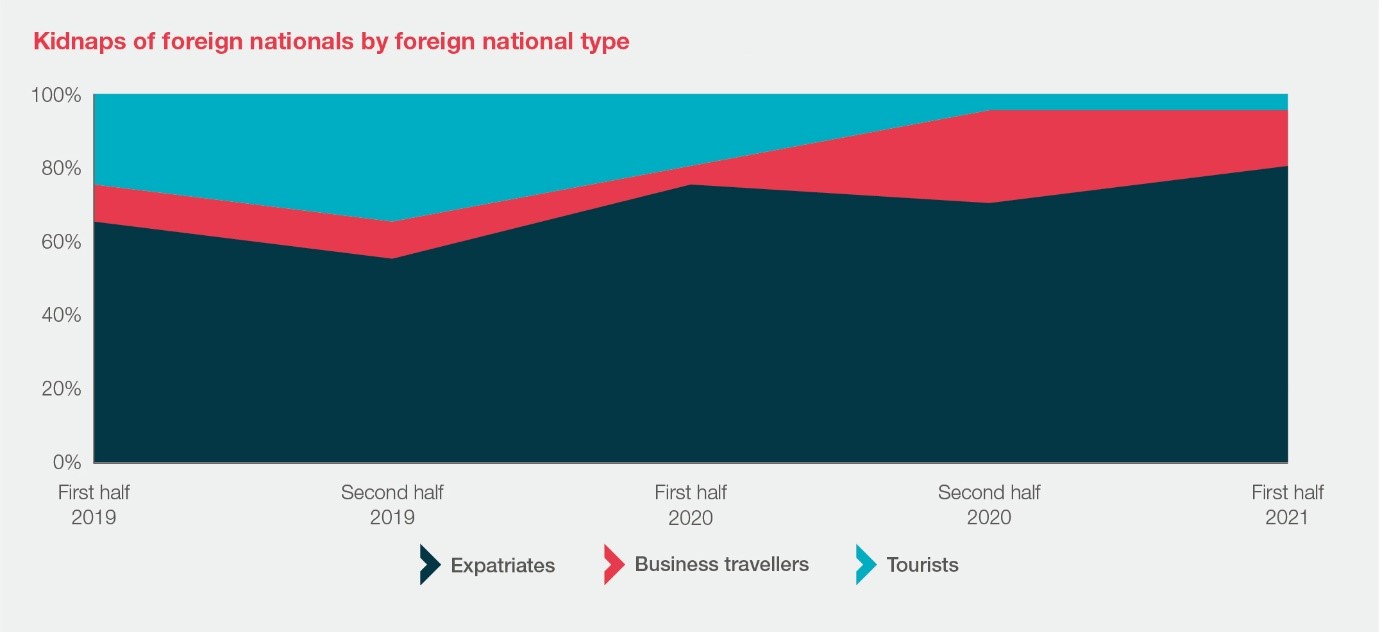
A return to business travel – mapping out the kidnap and extortive threat
Eighteen months into the pandemic, what are the trends?
The pandemic has caused a marked reduction in overseas travel. This has in turn had a noticeable influence on kidnapping patterns globally. Over 2020, Control Risks noted a decline in abductions of foreign nationals as a proportion of global incidents. This continued over the first half of 2021. Some 3% of victims between January and June 2021 were foreign nationals, down from 5% over the same period in 2020. However, this reduced proportion belies the fact that recorded numbers of incidents involving foreigners and total foreign victims currently sit at levels seen in 2019. Based on the numbers of kidnaps recorded, we assess that kidnappers retain the appetite to commit record levels of criminal activity, but are still being hampered by ongoing international restrictions.

Source: Control Risks, August 2021
Within the aggregate numbers of foreign national kidnaps, temporary visitors such as business travellers and tourists comprised a smaller contingent over the past 18 months. Although expatriates are typically the most common foreign national victim type year-to-year, the COVID-19 pandemic exacerbated this trend. Between January and June 2021, expatriates represented 80% of the foreign victims whose purpose in country was known, while only 15% were business travellers and 5% were tourists. The proportion of tourists and business travellers among kidnap victims represented a marked drop from the 44% combined seen in the second half of 2019. This can easily be accounted for by the pandemic-caused reduction in international mobility, which has drawn kidnappers’ focus towards the more limited pool of foreigners who have remained in country.
"Coming out of Covid 19 could lead to huge economic pressures on countries, businesses and people. K&R insurance has been there to provide protection against extortions such as, increased criminal activities like kidnappings and increased political unrest."
Stuart Allen, Hiscox London Market, Line Underwriter - Kidnap &Ransom.

Source: Control Risks, August 2021
Where are we headed?
Control Risks’ Special Risks analysts predict a rise in the kidnap threat to foreign nationals over the next one-to-two years. In many of the countries where kidnapping and extortive crime are common, a sustained economic downturn and proliferation of more sophisticated criminal gangs have caused kidnappers to operate increasingly aggressively.
Smaller criminal groups will remain as unlikely to target foreign nationals as they were pre-pandemic due to the increased police and media attention attracted by abductions of foreigners. The consequence of this attention is a higher likelihood of interception or arrest that generally deters less sophisticated prospective kidnappers. Conversely, having seen the proceeds of crime noticeably diminish during the pandemic, larger, more well-organised groups will be increasingly willing to take risks in return for the comparatively higher concessions they will expect from foreign victims. Although this will affect expatriates to a greater extent, kidnappers could also increasingly look to target both business travellers and tourists.
Travellers most at risk will typically either be those engaging in longer stays, which increase the likelihood of creating routines and attracting a gang’s attention, or those visiting locations where kidnappers are able to wholly operate with impunity, such as parts of Afghanistan, Haiti, north-eastern Nigeria and the Sahel region. Most short-term visitors typically avoid kidnap because the brief duration of their stays does not facilitate the creation of exploitable routines. Nonetheless, short-term travellers will face other forms of kidnap threats, such as express kidnapping (where kidnappers abduct victims for short periods and force them to withdraw sums of cash from automated teller machines to pay for their release). This is a more opportunistic crime, readily perpetrated by smaller criminal groups seeking a low risk payout. These groups have always had the intent to target foreign nationals but could seek to increase their activity to offset the periods of limited activity that they have experienced during local lockdowns.
An additional consideration will be the increased possibility of low-level extortion affecting travellers. Criminals across the world have developed both simple and complex scams to secure small payments from travellers. These range from relatively simple bar bill scams to more complex virtual kidnaps, in which criminals deceive victims into believing that they or a loved one are being held for ransom to extort money from them. These low-level forms of extortion will likely see the most marked rise of any extortive crime. Although many of these were previously well known to regular travellers, criminals have had time to update their scams and alter their tactics, making it more likely that individuals will again be vulnerable.
Overall, while a return to international travel will bring a plethora of benefits and opportunities for international business, so too will it present opportunities for criminals seeking to exploit a more mobile business world. Businesses will therefore have to consider the extortive threats posed to their employees, wherever they go. Organisations should ensure that any threat and risk assessments are updated with current analysis ahead of travel to account for how environments have changed during the pandemic period. This process should include locations that were frequently visited and familiar to travellers pre-pandemic.
This content has been provided by the Special Risks Analysis team at Control Risks. Visit the Control Risks website to find out more about our exclusive partnership.



